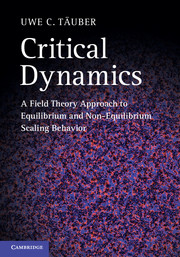Book contents
- Frontmatter
- Dedication
- Contents
- Preface
- Part I Near-equilibrium critical dynamics
- 1 Equilibrium critical phenomena
- 2 Stochastic dynamics
- 3 Dynamic scaling
- 4 Dynamic perturbation theory
- 5 Dynamic renormalization group
- 6 Hydrodynamic modes and reversible mode couplings
- 7 Phase transitions in quantum systems
- Part II Scale invariance in non-equilibrium systems
- Index
- References
4 - Dynamic perturbation theory
from Part I - Near-equilibrium critical dynamics
Published online by Cambridge University Press: 05 June 2014
- Frontmatter
- Dedication
- Contents
- Preface
- Part I Near-equilibrium critical dynamics
- 1 Equilibrium critical phenomena
- 2 Stochastic dynamics
- 3 Dynamic scaling
- 4 Dynamic perturbation theory
- 5 Dynamic renormalization group
- 6 Hydrodynamic modes and reversible mode couplings
- 7 Phase transitions in quantum systems
- Part II Scale invariance in non-equilibrium systems
- Index
- References
Summary
In this chapter, we introduce and explain one of the fundamental tools in the study of dynamic critical phenomena, namely dynamic perturbation theory. Inevitably, large parts of Chapter 4 need to be rather technical. Complementary to the straightforward iterative method for the solution of non-linear Langevin equations presented in Section 3.2.3, we now describe the more elegant and efficient field-theoretic techniques. Yet both for the derivation of general properties of the perturbation series and for the sake of practical calculations, the response functional and the following elaborations on Feynman diagrams, cumulants, and vertex functions prove indispensable. As is the case with every efficient formalism, once one has become acquainted with the Janssen–De Dominicis response functional for the construction of dynamic field theory, and therefrom the perturbation expansion in terms of vertex functions, it serves to save a considerable amount of rather tedious work. For the purely relaxational O(n)-symmetric models A and B, we derive the fluctuation-dissipation theorem within this formalism, and then systematically construct the perturbation series and its diagrammatic representation in terms of Feynman graphs. In order to reduce the required efforts to a minimum, the generating functionals first for the cumulants, and then, motivated by Dyson's equation for the propagator, for the one-particle irreducible vertex functions are examined. As an example, the relevant vertex functions for models A and B are explicitly evaluated to two-loop order. Furthermore, alternative formulations of the perturbation expansion are discussed, and the Feynman rules are given in both the frequency and the time domain. The results of this chapter provide the foundation for the renormalization group treatment in the subsequent Chapter 5.
Information
- Type
- Chapter
- Information
- Critical DynamicsA Field Theory Approach to Equilibrium and Non-Equilibrium Scaling Behavior, pp. 130 - 170Publisher: Cambridge University PressPrint publication year: 2014
References
Accessibility standard: Unknown
Why this information is here
This section outlines the accessibility features of this content - including support for screen readers, full keyboard navigation and high-contrast display options. This may not be relevant for you.Accessibility Information
- 1
- Cited by
